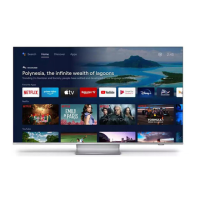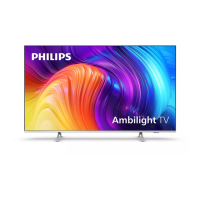Do you have a question about the Philips 50PUS8818 and is the answer not in the manual?
Explains the Dashboard panel for accessing settings, controls, and notifications.
Differentiates between Google TV and Basic modes, highlighting features.
Provides step-by-step instructions to open the Home screen and navigate items.
Emphasizes reading all safety instructions before using the TV.
Details instructions for mounting the TV stand and wall mount.
Explains how to connect the power cable securely and safely.
Guides on connecting the antenna cable for TV signal reception.
Explains how to connect the satellite F-type connector to the TV.
Details the functions of buttons on Type 1 and Type 2 remote controls.
Explains the process of pairing the remote control with the TV via Bluetooth.
Details how to switch the TV on, put it in standby, and reboot it.
Guides through installing satellite channels, including Unicable systems.
Offers solutions for common satellite installation issues.
Explains automatic and manual channel updates for antenna reception.
Guides on how to reset the TV to factory settings.
Provides steps to copy the current channel list to a USB drive.
Details how to upload a channel list to a TV.
Covers tuning to channels, switching, and previous channel.
Guides on locking/unlocking channels and parental rating settings.
Details HDMI quality, HDCP copy protection, and available ports.
Explains HDMI ARC/eARC connections for audio return.
Covers controlling HDMI CEC devices with the TV remote.
Discusses settings for Ultra HD signals on HDMI inputs.
Guides on connecting Home Theatre Systems via HDMI ARC/eARC.
Addresses issues like loud noise or no sound from HTS.
Explains connecting game consoles via HDMI for best quality.
Details connecting a computer to the TV via HDMI for PC monitor use.
Covers connecting the TV to a home network wirelessly or wired.
Explains signing into a Google account for full TV capabilities.
Covers picture settings, styles, and adjustments for optimal viewing.
Details advanced picture adjustments like contrast, brightness, and HDR.
Covers adjusting picture format to fill the screen and manual adjustments.
Details sound styles and basic sound adjustments.
Details controlling HDMI sound systems via EasyLink 2.0.
Guides on calibrating TV speakers to room acoustics for optimal sound.
Covers audio output settings, eARC, and digital output formats.
Details system software updates from the internet or USB.
Guides on reinstalling TV and resetting all settings to factory defaults.
Details setting up and changing child lock codes.
Explains how to restart the TV to improve performance.
Covers pairing and operating Bluetooth devices.
Details pairing and viewing information for the remote control.
Details using the Philips TV Remote App for control and features.
Guides on connecting consoles/computers for gaming.
Guides on setting up and using Alexa for TV control.
Details how to run TV diagnostics and self-diagnostics.
Provides solutions for common issues like no picture, poor sound, and remote control.
Addresses troubleshooting for HDMI, USB, and network connectivity issues.
Provides contact information for customer care and repair services.
Lists important safety instructions to prevent electric shock, fire, and injury.
Explains the Dashboard panel for accessing settings, controls, and notifications.
Differentiates between Google TV and Basic modes, highlighting features.
Provides step-by-step instructions to open the Home screen and navigate items.
Emphasizes reading all safety instructions before using the TV.
Details instructions for mounting the TV stand and wall mount.
Explains how to connect the power cable securely and safely.
Guides on connecting the antenna cable for TV signal reception.
Explains how to connect the satellite F-type connector to the TV.
Details the functions of buttons on Type 1 and Type 2 remote controls.
Explains the process of pairing the remote control with the TV via Bluetooth.
Details how to switch the TV on, put it in standby, and reboot it.
Guides through installing satellite channels, including Unicable systems.
Offers solutions for common satellite installation issues.
Explains automatic and manual channel updates for antenna reception.
Guides on how to reset the TV to factory settings.
Provides steps to copy the current channel list to a USB drive.
Details how to upload a channel list to a TV.
Covers tuning to channels, switching, and previous channel.
Guides on locking/unlocking channels and parental rating settings.
Details HDMI quality, HDCP copy protection, and available ports.
Explains HDMI ARC/eARC connections for audio return.
Covers controlling HDMI CEC devices with the TV remote.
Discusses settings for Ultra HD signals on HDMI inputs.
Guides on connecting Home Theatre Systems via HDMI ARC/eARC.
Addresses issues like loud noise or no sound from HTS.
Explains connecting game consoles via HDMI for best quality.
Details connecting a computer to the TV via HDMI for PC monitor use.
Covers connecting the TV to a home network wirelessly or wired.
Explains signing into a Google account for full TV capabilities.
Covers picture settings, styles, and adjustments for optimal viewing.
Details advanced picture adjustments like contrast, brightness, and HDR.
Covers adjusting picture format to fill the screen and manual adjustments.
Details sound styles and basic sound adjustments.
Details controlling HDMI sound systems via EasyLink 2.0.
Guides on calibrating TV speakers to room acoustics for optimal sound.
Covers audio output settings, eARC, and digital output formats.
Details system software updates from the internet or USB.
Guides on reinstalling TV and resetting all settings to factory defaults.
Details setting up and changing child lock codes.
Explains how to restart the TV to improve performance.
Covers pairing and operating Bluetooth devices.
Details pairing and viewing information for the remote control.
Details using the Philips TV Remote App for control and features.
Guides on connecting consoles/computers for gaming.
Guides on setting up and using Alexa for TV control.
Details how to run TV diagnostics and self-diagnostics.
Provides solutions for common issues like no picture, poor sound, and remote control.
Addresses troubleshooting for HDMI, USB, and network connectivity issues.
Provides contact information for customer care and repair services.
Lists important safety instructions to prevent electric shock, fire, and injury.
| Screen shape | Flat |
|---|---|
| Response time | - ms |
| Display diagonal | 50 \ |
| Display brightness | - cd/m² |
| Display technology | LED |
| Native aspect ratio | 16:9 |
| Native refresh rate | 120 Hz |
| Supported video modes | 576p, 720p |
| Display diagonal (metric) | 126 cm |
| Supported graphics resolutions | 640 x 480 (VGA), 1920 x 1080 (HD 1080), 2560 x 1440, 3840 x 2160 |
| Display refresh rates supported | 24 Hz, 25 Hz, 30 Hz, 50 Hz, 60 Hz, 100 Hz, 120 Hz |
| Motion interpolation technology | - |
| Tuner type | Analog & digital |
| Analog signal format system | PAL, SECAM |
| Digital signal format system | DVB-C, DVB-S, DVB-S2, DVB-T, DVB-T2, DVB-T2 HD |
| Music apps | YouTube Music |
| Video apps | Amazon Prime Video, Apple TV, BBC iPlayer, Disney+, Netflix, YouTube |
| App distribution platform | Google Play |
| Operating system installed | Google TV |
| Sound modes | AI Sound |
| Audio decoders | DTS, Dolby Atmos, Dolby Digital, DTS:X, Dolby MS12 |
| RMS rated power | 40 W |
| Wi-Fi standards | Wi-Fi 5 (802.11ac) |
| Bluetooth version | 5.0 |
| Stand type | Center stand |
| Stand color | Gray |
| Product color | Anthracite, Grey |
| Panel mounting interface | 200 x 300 mm |
| Game features | Auto Low Latency Mode (ALLM), Variable Refresh Rate (VRR) |
| AMD FreeSync type | FreeSync Premium |
| Teletext standards | Hyper-text |
| Audio formats supported | AAC, FLAC, MP3, WAV, WMA, WMA-PRO |
| Image formats supported | BMP, GIF, HEIF, JPEG, PNG |
| Video formats supported | AVC, AVI, H.264, HEVC/H.265, MKV, MPEG1, MPEG2, MPEG4, VP9 |
| Subtitle formats supported | ASS, SMI, SRT, SSA, SUB, TXT |
| Picture processing technology | Philips P5 Perfect Picture Engine |
| High Dynamic Range (HDR) technology | Dolby Vision, High Dynamic Range 10 (HDR10), High Dynamic Range 10+ (HDR10 Plus), Hybrid Log-Gamma (HLG) |
| USB 2.0 ports quantity | 2 |
| Ethernet LAN (RJ-45) ports | 1 |
| Programming period | 8 day(s) |
| AC input voltage | 220 - 240 V |
| AC input frequency | 50/60 Hz |
| Power consumption (standby) | 0.3 W |
| Power consumption (typical) | - W |
| Cables included | AC |
| Package type | Box |
| Package depth | 180 mm |
| Package width | 1240 mm |
| Package height | 800 mm |
| Package weight | 19800 g |
| Battery type | AAA |
| Ambient lighting type | 3-sided |
| Internal memory | 16000 MB |
| Stand width | 500 mm |
|---|---|
| Depth (with stand) | 259 mm |
| Width (with stand) | 1116 mm |
| Height (with stand) | 715 mm |
| Weight (with stand) | 15800 g |
| Depth (without stand) | 81 mm |
| Height (without stand) | 655 mm |
| Weight (without stand) | 13100 g |











